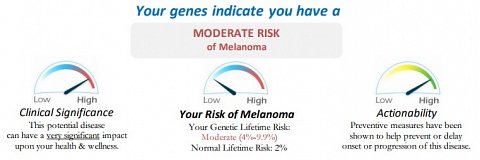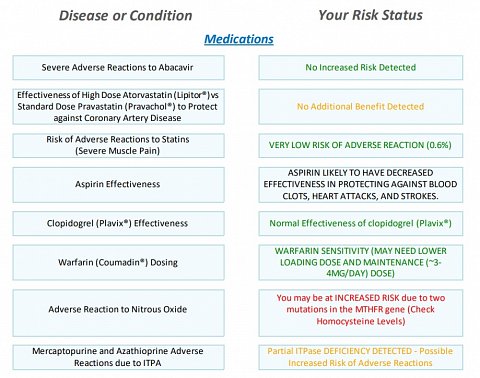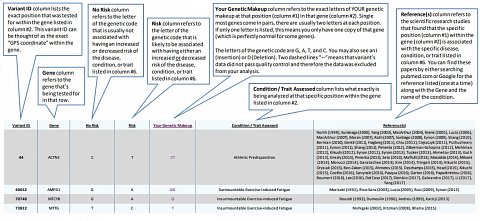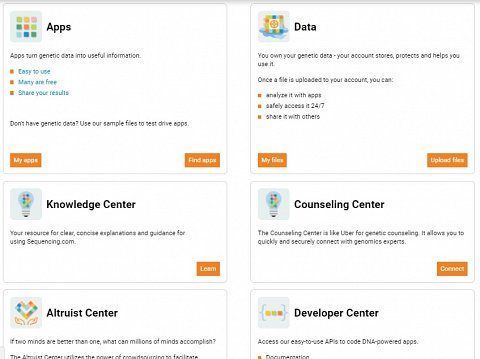-
Sequencing
review on 6 February 2018
by Ellen Hinkley

At a Glance
Summary
Sequencing.com provided a useful platform for re-using my genetic data. I thought the range of web apps on offer was good and I was happy to find both free and ‘paid for’ services. The wide range of data accepted was also impressive, and I really appreciated the level of control I had over my data within the account.
I did feel a bit let down by the lack of support available, especially considering the serious conditions covered by one of the apps I bought (the Wellness and Longevity web app). That said, this app contained a wealth of information and was definitely worth the price.
Sequencing.com provided an effective means of re-using the genetic data I’d acquired from a previous DNA test, and I’d recommend it to those who want additional insights into their genetic makeup.
Full Review
Sequencing.com is the company behind the world’s first DNA app store. It was founded in 2014 by Brandon Colby, an American physician and author of the popular book, ‘Outsmart your Genes’ which explores the preventative benefits of genetic testing. The website was launched globally two years later in 2016 as a platform for researchers, bioinformaticians, app developers and individuals, as an easy way to store, use and understand genetic data.
The Sequencing.com platform is agnostic, meaning it accepts various types of genetic data, from almost any company. I recently had my genome sequenced, so I decided to give their service a go with the raw data I’d received.
Product Expectations
Sequencing.com’s homepage described the service as ‘The app store for your genes’ and reiterated that I could upload any type of data. I read that the service was also the world’s largest marketplace for apps that analyse genetic data, but I know this to be wrong as MyGenomeBox has more. I read that Sequencing.com would provide me with the chance to obtain insights into my DNA, and I’d also have the opportunity to become an ‘Altruist’ by supporting scientific research.
I was intrigued about what being an Altruist meant, so I clicked to read more. I found out that I could make my data available to researchers via an open ‘Altruist Database’. I was pleased to read that this was an opt-in feature and that my data would be completely anonymised, meaning that no-one would be able to use it to identify me. I was also happy to read that Sequencing.com wouldn’t ever sell or make money from my data.
I browsed the app store before signing up. There were some featured apps, a top eight chart, as well as several app category sections and the option to see all available apps. I could see that there were quite a few free options and some that were pretty cheap. Unfortunately it wasn’t possible to sort the apps by price, popularity or anything else. That said, it was easy to browse all 49 apps (most were web apps, only three were mobile apps), to find the ones that interested me.
Each app description I looked at included sample results, and some even came with introductory videos. Once I’d looked through the selection available, I decided on the ‘Wellness and Longevity’ web app (which was actually developed by Sequencing.com). This would help me to ‘Predict’, ‘Prevent’ and ‘Prevail’, by providing information about my genetic predispositions and ways in which I could take action to reduce risks and potentially prolong my life.
The app description page included samples of the report, information on exactly what I’d learn, guides on how to purchase/use the web app, FAQs and even technical information about how my genetic data would be translated into results.
Ordering Experience
To order the web app, I knew I’d have to create a Sequencing.com account so I clicked the ‘Login to access’ button on the product description page. I was taken to a login page, which also included a ‘Register’ button. I was able to register using my email address or via my 23andMe, AncestryDNA, Google, Facebook or GitHub account. I chose to use the first option and once I’d inputted it, I received an email with an activation link.
Next, I was guided through a few more steps, first choosing whether I was an ‘Individual or Family’, an ‘App Developer’, a ‘Laboratory’, a ‘Healthcare Professional’ or a ‘Researcher’.
I then entered my name and a password and was asked whether I had genetic data. Before uploading mine, I read through the T&Cs and Privacy Policy. I was impressed to read that they wouldn’t use my genetic data for anything other than to provide the services I requested.
There was more information about creating an ‘Altruist File’, which reiterated that I was under no obligation to share my data and could delete it at any point. One small caveat was that if the data I chose to share was used to develop any commercial products, I wouldn’t be able to claim any compensation. Overall, however, I felt that my data was better protected than with most companies and appreciated having so much control over its use.
Data Upload
Having looked through Sequencing.com’s policies, I was happy to go ahead and upload my data. I was using the whole genome sequencing (WGS) data I’d purchased previously, so I used the ‘Big Yotta’ uploader they recommended for large files. I was also given the option to connect my Sequencing.com account to my 23andMe or AncestryDNA accounts, or to upload smaller files directly from my computer or the cloud.
Once my data had been uploaded and validated, I clicked to purchase the Wellness and Longevity web app, which, at $65 per file, seemed quite pricey for a reanalysis service. However, I entered my payment details and when the payment went through, I received an email to confirm and waited while the app analysed my data. As this was happening, I was given the option to play a puzzle which I thought was a great feature. It was an online Rubik’s cube that I found myself happily distracted with while my data processed.
The Results
When my results were ready, I received an email notification with a link taking me directly to them. The report was a PDF file, which could be viewed on the Sequencing.com website or downloaded.
A title page was followed by a welcome note and disclaimer. This disclaimer was nearly a page long and warned me not to rely on the results as medical advice, listing the limitations of the analysis.
The next section included detailed advice about how to read the report. This explained that the conditions or traits included had been assigned an ‘Overall Lifetime Risk’. It was made clear that having an increased risk didn’t mean I did or would ever have the condition, just that I would be more likely than average to develop it. It also explained that being a carrier meant that I didn’t have the condition myself, but could potentially pass it on to my children, if my partner was also a carrier.
As well as the implications of the results, some of the ways in which they were displayed were explained. I saw that gauges would be used to show the ‘Risk’, ‘Severity’, ‘Clinical Significance’ and ‘Actionability’ associated with each result. In addition to the information I’d receive via these gauges, I would learn the typical age of onset for the conditions reported on, the symptoms, and I’d be given genetically tailored prevention methods.
Results Section: Detailed Results
The results themselves were split into three main sections, the first of which provided detailed results for seven traits and conditions. These were ‘Athletic Performance’, ‘Melanoma’, ‘Arthritis’, ‘Osteoporosis’, ‘Malignant Hyperthermia’, ‘Heart Attack’ and ‘Preventable Sudden Death’.
Each of these results included a short introduction and gauges to display the different parts of my result. I found out that I was better suited to power rather than endurance-type athletic activities, was at a low risk of exercise-induced fatigue and muscle damage, low risk of malignant hyperthermia and low risk of sudden death due to heart arrhythmia. However, I had a moderate risk of melanoma osteoporosis, heart attack and an increased risk of arthritis. The gauges provided a good way of seeing my results at a glance, though I found that they sometimes caused a bit of confusion as the overall risk appeared lower on the gauge than the accompanying text explained. This was the case for my melanoma result (shown below).

My Melanoma result.
I came away from this result with the understanding that my risk was moderate, and I found that the comparison of my result to the ‘Normal Lifetime Risk’ helped me put it into context.
The ‘Genetically Tailored Prevention’ section for each result provided advice that was sorted into nine categories: ‘Monitoring’, ‘Medication & Supplements’, ‘Alternative Interventions’, ‘Myths & Misconceptions’, ‘Lifestyle Modifications’, ‘Additional Resources’, ‘Disease Interventions’, ‘Complementary Interventions’ and ‘Family Planning’ (though not all results included all of these categories).
I thought the Lifestyle Modifications were particularly helpful as they provided easily implementable advice. To reduce the impact on vulnerable joints for example, I was advised to swap activities like running for things like cycling, swimming or yoga.
Whilst most of these recommendations seemed personalised and useful, there were a few examples where the advice was not so relevant. My Osteoporosis result, for example, included the recommendation that I start integrating strength training into my exercise routine ‘Starting at age 20’. As someone well into my 30s, this advice was a bit disheartening as it gave the impression that I’d missed the boat for effective intervention.
Overall though, I found most of the advice useful and the descriptions of the results comprehensive. I was also impressed that further resources were provided for each, giving me a starting point from which to research more if I’d wanted to.
Results Section: Other Results
The next section of the report was made up of listed results, shown in tables and sorted by category. The tables contained two columns, ‘Disease or Condition’ and ‘Your Risk Status’ and were sorted into the following categories: ‘Medications’, ‘Cancer’, ‘Heart and Blood Vessels’, ‘Child Development’, ‘Fertility’, ‘Digestive Tract & Liver’, ‘Blood’, ‘Neurology’, ‘Pulmonology’, ‘Infectious Disease’ and ‘Hearing’. Most included between one and five results, except Medications (13) and Blood (18). Some of my Medications results are shown below.

Some of my Medications results.
The way that these results were set out made them easy to assess, with the use of colours helping to highlight areas of concern. Looking through them, I was worried to read that I was at an increased risk of suffering from a brain aneurysm. All I knew about this condition was that it usually happened unexpectedly and was often fatal, so the lack of any extra information about it made it all the more distressing. After doing some of my own research into the condition online, I was pleased to read that genetics wasn’t mentioned as a common risk factor, and even having a documented family history didn’t increase the risk dramatically. I wished that this had been explained in the report as it would have made me a lot less panicked when first reading the result.
Overall this section was useful and provided quick, easy to understand results, but in comparison to the range of features the previous section had provided, I felt a little unsupported.
Results Section: Your Genetic Testing Data
The final section gave me the chance to look at the results for individual genetic variants. It made up about 140 pages in total and included hundreds, if not thousands of individual results (though I imagine this would have been shorter for those not using WGS data). Unfortunately, there were no page numbers and the conditions weren’t sorted alphabetically, which made it a little difficult to navigate, so I ended up using Ctrl+F to find specific results.
I was impressed with the thorough explanations that accompanied the table and liked that they had been split into several speech bubbles (shown below).

The Your Genetic Testing Data table with explanations of the different columns.
Marketplace Experience
Once I’d looked through the Wellness and Longevity web app results I went back to my Sequencing.com account to have a look at the other features of the service. I logged in to a dashboard page which provided several options. Six boxes provided quick links to the six main parts of the site, ‘Apps’, ‘Data’, ‘Knowledge Center’, ‘Counseling Center’, ‘Altruist Center’ and ‘Developer Center’. Part of this dashboard is shown below.

A part of my account dashboard.
Having been a bit concerned about my brain aneurysm result, I was relieved to find the Counseling Center. It was described as the ‘Uber’ of genetic counselling, though I was disappointed to see that when I clicked to ‘Connect’, I was greeted with the message that it would launch in ‘Fall 2017’. This was in January 2018, so it seemed that the launch of this service had been delayed or abandoned. The Knowledge Center provided helpful guides to using the site and its various features, which I didn’t really need to use, but was glad to have the guidance available.
I appreciated being able to manage my data, though was confused to see that I had been given a ‘My Altruism’ score of 50, despite not opting in to the Altruism feature. When I clicked to see more, it showed that this had been earned from ‘App Rewards’ (shown below), but I had no idea what App Rewards were or why the corresponding switch was turned ‘On’.

My Altruism score.
Finally, going back to Sequencing.com’s main apps section, I noticed that I could use their sample files to preview any app which was another useful feature. I tried out the ‘Lactose Intolerance’ web app and was impressed by how quickly and easily I was able to view the sample results.
Another useful feature is that whilst you’re logged in to Sequencing.com, it’s a simple matter to browse apps and click ‘Add to my apps’ to immediately access free services, or to purchase ‘paid for’ ones.
Summary
Sequencing.com provided a useful platform for re-using my genetic data. I thought the range of web apps on offer was good and I was happy to find both free and ‘paid for’ services. The wide range of data accepted was also impressive, and I really appreciated the level of control I had over my data within the account.
I did feel a bit let down by the lack of support available, especially considering the serious conditions covered by one of the apps I bought (the Wellness and Longevity web app). That said, this app contained a wealth of information and was definitely worth the price.
Sequencing.com provided an effective means of re-using the genetic data I’d acquired from a previous DNA test, and I’d recommend it to those who want additional insights into their genetic makeup.
Visit Sequencing to learn more about this DNA testing service >


